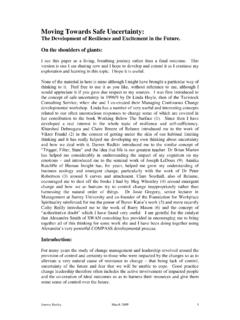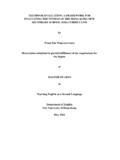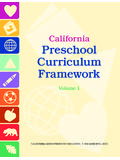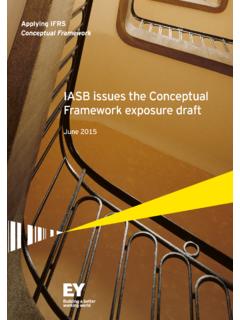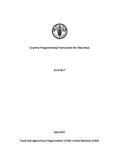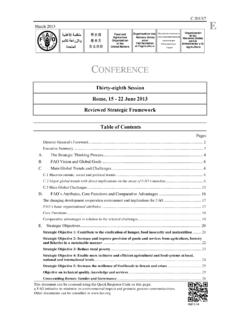Transcription of Coaching framework for ensuring value - …
1 Coaching framework A framework within which Coaching can be set-up, provided, assessed and measured Introduction The aim of this document is to help those who are considering setting up formal Coaching in an organisation think through how they might do that in a complete and holistic way. It therefore lays out a possible framework which considers how coaches can be assessed and monitored, how the Coaching can be set up effectively and then measured usefully and how the aims of the organisation can be brought to the Coaching conversation whilst retaining the safety and confidentiality of the coach/coachee relationship.
2 The document lays out: 1. The aims and principles that need to be applied in setting up the Coaching and in determining the assessment 2. The overall mechanisms that underpin this framework 3. The creation of a pool of fully briefed and assessed coaches 4. The process for setting up the Coaching effectively and assessing the increased value the coachee delivers into the organisation 5. The assessment of the quality of the Coaching conversations 6. The assessment of the value individual coachees get from the Coaching 7. The development of internal coaches 8. The process of supervision.
3 The scope of this framework covers both external Coaching and internal Coaching . 1 Key principles and aims The key objectives of this framework are as follows: To maximise the opportunity for individuals being coached to grow and develop themselves To optimise the bottom-line benefit to the organisation of any Coaching done in the organisation, and to significantly improve the opportunity for the Coaching to add benefit to the organisation To ensure the integrity of any expenditure by and within the organisation To ensure that Coaching is applied appropriately and is not used in a way which unduly influences any decision-maker.
4 This is in the context that Coaching shares a boundary with some therapeutic tools and processes. There are some fundamental philosophies that underpin this framework proposal: Any Coaching within the organisation should enhance the ability of all its leaders to coach and should grow the stock of good internal coaches, regardless of how they might be used Every excellent coach has their own unique approach which provides value in its own way. This framework aims to enhance the opportunities for that uniqueness to be brought to the organisation. This framework assumes some core principles which protect the integrity of the Coaching itself.
5 These are: The coachee s content should remain absolutely confidential to the coachee and their coach. There should be no possible question that this should be shared in any way except by the coachee in the way that they choose. The coach should not be put in a position whereby they are asked to share the coachee s content with anybody. All achievements of the coachee are theirs and theirs alone. The Coaching has contributed only to the extent that any good tool might. Everything the coachee has achieved is down to the way that they have used the Coaching effectively and changed/transformed as a result.
6 For them to not take full credit for this, takes away from their learning about themselves and their use of these tools moving forward. Individual Coaching should be primarily focused on the individual s development need. Therefore, the coachee determines what they want to work on about themselves with their coach. They decide how much of their personal agenda needs to align to that of the organisation. The coach might challenge and question the way in which the coachee considers the organisational agenda but it is not the responsibility of the coach to bring the organisational agenda if the coachee chooses not to consider it.
7 For an individual to be important enough to be given Coaching , they are able to be trusted to bring the appropriate agenda to their Coaching this does not need to be validated by the coach. Any report back to manager or internal funder by the coach about the coachee s agenda is a clear transgression of their confidentiality and responsibility. The coach should not be involved in any assessment of the coachee. Lack of judgement or, at least, the transparency of judgements formed by the coach about the coachee is a critical part of Coaching methodology. As soon as the coach is required to form any sort of assessment of the coachee for some wider organisational purpose, a dynamic is created within the Coaching which can be extremely unhelpful.
8 The coachee, at some level, pays attention to impressing the coach rather that opening themselves up to clarity and transparency in their own thinking and self-image. Furthermore, the coach is not usually in a position to know/assess the impact of the change in the coachee on their environment. Coaching works most effectively when it is holistic working with the whole individual not just on their organisational performance. The way in which the individual applies their values, focuses their energy and commitment, understands where and why they perform at their best and understands and works to their personal needs and preferences all requires an understanding of their wider needs and commitments not just those which apply to work.
9 The transparency of the impact that the coachee s improved performance has on the organisation s results is a critical part of the growth and learning of the coachee. Therefore, it is critical that the key stakeholders in that performance and growth are involved in discussion with the coachee about this. The more that Coaching can be seen to be adding value to the bottom-line. Coaching works most effectively when it is something that the coachee chooses to undertake and when the coachee chooses the coach. Individual Coaching is about helping the individual being coached be the best they can be both in the current role and in their ongoing development as a leader in the organisation (including their future career).
10 The coach is not there to make wider changes in the organisation nor to help their client except through the Coaching process. Any changes that need to be made in the wider organisation are best enabled by the coachee as part of their development and as part of ensuring their self-sufficiency and the self-sufficiency of the organisation in a wider sense. The above principles apply to both internal and external coaches. With internal Coaching specifically, it is critical that the coachee chooses their coach and believes that there is sufficient distance between them organisationally so that they can remain independent enough to provide the challenge and support necessary.
